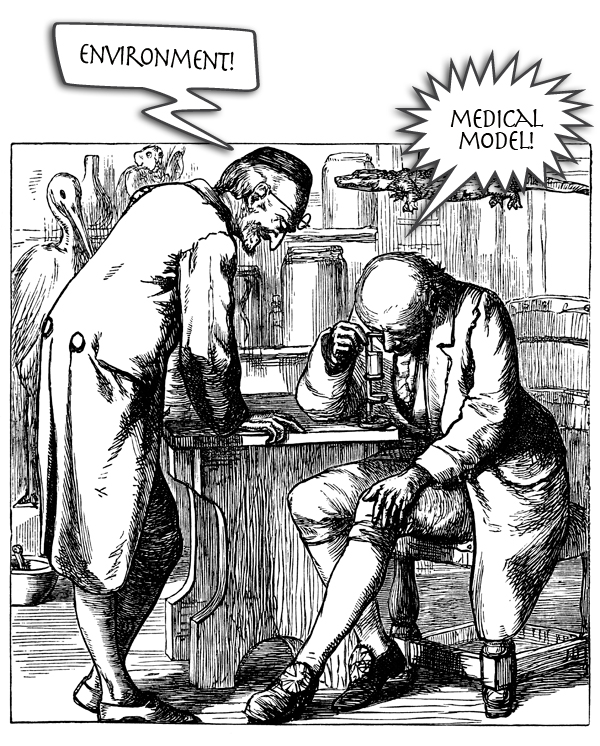Symptoms, Causes, and Behavioral Enviroscience (a.k.a. Behavior Analysis)
 Way back in the 1950s and ‘60s, early behavior analysts waged a war of ideas with the established psychiatric practices of treating behavior problems. Those proto-behavior analysts attacked something they called the “medical model,” which assumed that behavior problems were a “disease” with underlying causes that had to be addressed. The idea came largely, though not exclusively, from psychoanalysis, which of course had deep roots in the medical discipline of psychiatry. Psychiatrists and other adherents to a medical model in turn criticized behavior analysis as being superficial and concerned only with treating symptoms while leaving the root cause of the problem, lurking somewhere within the brain or soul or mind of the person. Worse yet, it was assumed that if one merely eliminated a symptom, another would take its place because of this failure to eliminate the problem’s root cause.
Way back in the 1950s and ‘60s, early behavior analysts waged a war of ideas with the established psychiatric practices of treating behavior problems. Those proto-behavior analysts attacked something they called the “medical model,” which assumed that behavior problems were a “disease” with underlying causes that had to be addressed. The idea came largely, though not exclusively, from psychoanalysis, which of course had deep roots in the medical discipline of psychiatry. Psychiatrists and other adherents to a medical model in turn criticized behavior analysis as being superficial and concerned only with treating symptoms while leaving the root cause of the problem, lurking somewhere within the brain or soul or mind of the person. Worse yet, it was assumed that if one merely eliminated a symptom, another would take its place because of this failure to eliminate the problem’s root cause.
 The latter was the first to fall under the blows of Occam’s razor dealt by those proto-behavior analysts: eliminate the symptom and the problem often disappeared. Nonetheless, the question of a root cause for many outside behavior analysis lingered, and lingers still today.
The latter was the first to fall under the blows of Occam’s razor dealt by those proto-behavior analysts: eliminate the symptom and the problem often disappeared. Nonetheless, the question of a root cause for many outside behavior analysis lingered, and lingers still today.
Of course, cause itself is a vague concept. Since at least the time of Aristotle, philosophers and scientists alike have recognized that there are different kinds of causes, and that cause becomes a matter of context and perspective, rather than the absolute entity it often was portrayed to be in invoking the medical model.
 We behavioral enviroscientists today assert that in treating symptoms we are indeed addressing the cause of the behavior. It is our view that such cause is in the environment and in the interactions between that environment and the person. Rather than being a mere stage on which behavior problems originating in the mind or brain or soul play out, the environment is the source of behavior, including behavior problems. Behavior problems are defined by the environments in which they occur. Rob Dunn, in a fascinating book on digestive disorders, and evolutionary biology entitled The Wild Life of Our Bodies, makes exactly this point with respect to an organism’s basic biology. He said “pick any organism on earth and as much of its biology is defined by how it interacts with other species as is influenced by the basics of living, eating, breathing, and mating.” Both biology and behavior thus are not something an organism possesses, they are defined by their interactions with environments. In other words, the environment is as much the cause of behavior as is anything else, in my view more than anything else.
We behavioral enviroscientists today assert that in treating symptoms we are indeed addressing the cause of the behavior. It is our view that such cause is in the environment and in the interactions between that environment and the person. Rather than being a mere stage on which behavior problems originating in the mind or brain or soul play out, the environment is the source of behavior, including behavior problems. Behavior problems are defined by the environments in which they occur. Rob Dunn, in a fascinating book on digestive disorders, and evolutionary biology entitled The Wild Life of Our Bodies, makes exactly this point with respect to an organism’s basic biology. He said “pick any organism on earth and as much of its biology is defined by how it interacts with other species as is influenced by the basics of living, eating, breathing, and mating.” Both biology and behavior thus are not something an organism possesses, they are defined by their interactions with environments. In other words, the environment is as much the cause of behavior as is anything else, in my view more than anything else.
 So all along, I would argue, behavior analysts have been searching for the causes of behavior. They have not been sticking their heads in the metaphorical sand and ignoring cause when treating “symptoms.” The symptom is indeed the problem, but its cause is environmental. Change the environment, change the behavior, is a common expression among behavioral enviroscientists. In this sense, it remains the case that eliminating symptoms does eliminate the problem. The reason it eliminates the problem is because this type of treatment does get at the cause of the behavior – the environment.
So all along, I would argue, behavior analysts have been searching for the causes of behavior. They have not been sticking their heads in the metaphorical sand and ignoring cause when treating “symptoms.” The symptom is indeed the problem, but its cause is environmental. Change the environment, change the behavior, is a common expression among behavioral enviroscientists. In this sense, it remains the case that eliminating symptoms does eliminate the problem. The reason it eliminates the problem is because this type of treatment does get at the cause of the behavior – the environment.
Of course there are biological/neurological functions that are correlated with certain kinds of behavior, but these functions have no first or a priori claim to cause than does the environment in which the behavior occurs. When addressing behavior problems, the first place people look for cause should not be vague internal physical or mental mechanisms, but the context in which the behavior is occurring.



